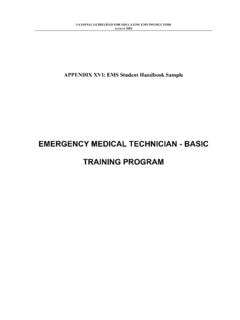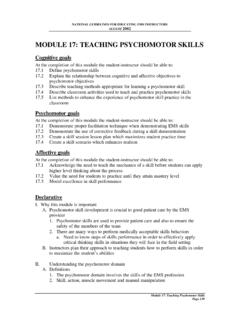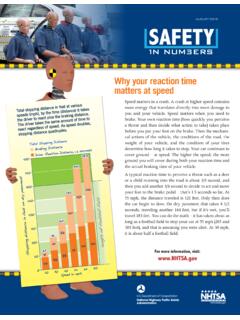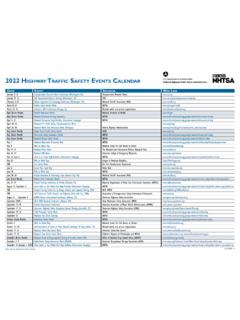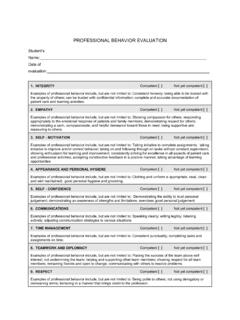Transcription of MODULE 12: EVALUATION TECHNIQUES
1 NATIONAL GUIDELINES FOR EDUCATING EMS INSTRUCTORS. AUGUST 2002. MODULE 12: EVALUATION TECHNIQUES . Cognitive goals At the completion of this MODULE the student-instructor should be able to: Define EVALUATION , formative EVALUATION and summative EVALUATION Distinguish between formal and informal EVALUATION Identify various types of EVALUATION , and the advantages and disadvantages of each Understand specific types of test items and the advantages and disadvantages of each Understand general guidelines for test construction Define reliability Define content validity List several examination resources Psychomotor goals At the completion of this MODULE , the student-instructor should be able to.
2 Develop two examples of correctly constructed test items for cognitive EVALUATION in each of the following categories: Multiple choice True/false Matching Completion Essay Develop a skills checklist to evaluate a psychomotor skills performance Affective goals At the completion of this MODULE , the student-instructor should be able to: Explain why EVALUATION is important to the total quality control of an EMS program Explain why formative and summative evaluations are both important in the EVALUATION process Declarative I. Why this MODULE is important A. Without a mechanism to evaluate the student you will never know if you have achieved the objectives and goals of instruction B.
3 The EVALUATION process helps determine strengths and weaknesses of students and your program 1. Program evaluations help improve the quality of the instruction 2. Student evaluations help determine whether students are progressing satisfactorily 3. Evaluations can also be used to determine if an individual is compatible with the EMS field (by targeting the affective domain). a. See the appendix for a sample affective domain EVALUATION tool MODULE 12: EVALUATION TECHNIQUES Page 103. NATIONAL GUIDELINES FOR EDUCATING EMS INSTRUCTORS. AUGUST 2002. C. Entry level EMS instructors may not design and develop test items (questions), but should have familiarity with the concepts of EVALUATION and how to construct solid test items 1.
4 Even if using a prepared test bank, you should understand how to determine if these questions are well written and match the objectives of your lesson plan II. EVALUATION A. Process of making a value judgment based on information from one or more sources B. A mechanism of determining student progress toward, or the attainment of, stated cognitive, psychomotor, and affective objectives C. The EVALUATION process should look at two components 1. Instruction as provided by the instructor 2. The performance of the student on course and lesson objectives III. Purpose of EVALUATION A. Provide feedback to student on progress or performance B.
5 Provide student gratification and motivation to succeed C. Measure effectiveness of teaching style and content of lesson D. Measure effectiveness of the educational program in meeting written goals and objectives IV. Formative EVALUATION A. Ongoing EVALUATION of the students and instruction conducted throughout the course 1. Compare the overall goal of instruction, lesson objectives and the content to the performance by the students 2. Compare the objectives of the course to the testing strategy a. Cognitive component: testing knowledge b. Psychomotor component: testing skill performance c. Affective component: testing attitudes, beliefs, ethics and morals B.
6 Formative EVALUATION is important in gaining insight early in the program 1. Use this information to make changes in the program, to provide remediation, or to redirect presentations C. Methods of performing formative EVALUATION during a course or class 1. MODULE or section testing within a larger topic area is a form of formative EVALUATION 2. Taking their temperature is an informal method of obtaining a quick response of student's questions or to clarify content just delivered a. Two of the many methods to take their temperature i. One minute paper: ask student to write their response to a question then compare their answer to another student's ii.
7 The muddiest point: ask students to write any questions they have on note cards and collect prior to a break a.) After the break begin with a review of the most common questions 3. Give frequent, short-duration written or practical drills or quizzes a. The intent is to provide feedback to both the student and instructor on the progress of the student V. Summative EVALUATION MODULE 12: EVALUATION TECHNIQUES Page 104. NATIONAL GUIDELINES FOR EDUCATING EMS INSTRUCTORS. AUGUST 2002. A. Summative EVALUATION is performed at the completion of the delivery of a larger section of material, a MODULE or program B.
8 Provide feedback to the students of their successful mastery of the content C. Determine the effectiveness of teaching strategy and to improve future teaching performance D. Methods of performing summative EVALUATION during a course or class 1. Survey tools a. Gather opinions about various aspects of the course and instruction 2. Comparison of course and program outcomes a. Determine if all goals and objectives were met 3. Final examinations: practical and written 4. Test item validation a. Determine if questions were valid b. Psychometric assessments can be performed to validate tests and questions i.
9 This level of EVALUATION is beyond an entry level EMS instructor E. A formative EVALUATION can also be summative 1. Depending upon the context in which it is used, a test may represent formative or summative EVALUATION a. For example: a multiple-choice final exam given at the end of a topic will be both formative and summative i. It is summative because it represents the end of that topic area ii. It is formative because it represents only a part of a course VI. Formal and informal EVALUATION A. Both formal and informal strategies are critical to the success of courses and programs B. Some of the EVALUATION strategies listed can be conducted formally or informally C.
10 Formal EVALUATION 1. A structured instrument to assess student's attainment of interim and/or terminal course objectives 2. A formal written examination can determine a grade for a course or serve as a means to continue in the program 3. If you review the test and allow students to challenge questions (prove it wrong through the use of textbooks and class notes, etc.) it can serve as a powerful learning tool 4. Problems with formal EVALUATION TECHNIQUES a. Place stress on the student (especially the ill-prepared ones). b. May not provide a mechanism for remediation or retention when they represent a final summation of learning D.

